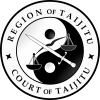Difference between revisions of "Template:Current featured article"
(+Last election template) |
(New article) |
||
| Line 1: | Line 1: | ||
| − | [[image: | + | [[image: CourtSeal.png|left|100px|Seal of the Senate of Taijitu]] |
| − | The ''' | + | The '''Court of Taijitu''' is the sole judicial body of [[Taijitu]]. It is composed a chief justice who administers the Court's business and any number of associate justices who rule on cases alongside the chief justice. Currently only the office of chief justice is occupied. All justices are appointed through nomination by the [[Delegate of Taijitu|delegate]] and subsequent confirmation by the [[Senate of Taijitu|Senate]]. They serve for terms of fourteen weeks or until removed by the Senate. The Court tries all criminal and civil cases under Taijituan jurisdiction, and arbitrates disputes between Taijituan citizens. The Court is also explicitly granted the power of judicial review by the [[Constitution of Taijitu]], and may strike down government acts or laws which it deems to be unlawful or unconstitutional. |
| − | The | + | The history of Taijitu's judicial system is not as storied as that of the other two branches of government. Its powers have remained effectively unchanged, while its structure has only varied slightly. The first judicial body of Taijitu under the region's original constitution was the Supreme Court. There was no constitutionally mandated distinction between associate justices and and a chief justice responsible for administering the court, and the maximum number of justices was limited to nine. A new constitution later briefly changed the maximum of nine justices to a minimum of one justice. This state of affairs was short lived, and the previous constitution was soon restored. When the current [[Constitution of Taijitu|constitution]] was drafted. the judiciary's name was changed for a second time to simply the Court of Taijitu, and any constitutional limitations on the size of the Court were removed. Meanwhile the then single office of justice was split into the offices of associate justice and chief justice. |
| − | The | + | The appointment of justices is a two step process. The [[Delegate of Taijitu|Delegate]] must first nominate a candidate. Nominees must then be confirmed by a two-thirds majority vote of the [[Senate of Taijitu|Senate]] before they can become a justice. Though not constitutionally required, votes on whether to confirm a nominee for justice have often been preceded by some manner of formal review. Once in office, justices serve for fourteen week terms. They may be removed prematurely from office by a two-thirds majority vote of the Senate. As unelected officials, justices may not be recalled like the Delegate and senators. |
| − | :Main article: [[ | + | :Main article: [[Court of Taijitu]] |
Revision as of 16:45, 17 February 2012
The Court of Taijitu is the sole judicial body of Taijitu. It is composed a chief justice who administers the Court's business and any number of associate justices who rule on cases alongside the chief justice. Currently only the office of chief justice is occupied. All justices are appointed through nomination by the delegate and subsequent confirmation by the Senate. They serve for terms of fourteen weeks or until removed by the Senate. The Court tries all criminal and civil cases under Taijituan jurisdiction, and arbitrates disputes between Taijituan citizens. The Court is also explicitly granted the power of judicial review by the Constitution of Taijitu, and may strike down government acts or laws which it deems to be unlawful or unconstitutional.
The history of Taijitu's judicial system is not as storied as that of the other two branches of government. Its powers have remained effectively unchanged, while its structure has only varied slightly. The first judicial body of Taijitu under the region's original constitution was the Supreme Court. There was no constitutionally mandated distinction between associate justices and and a chief justice responsible for administering the court, and the maximum number of justices was limited to nine. A new constitution later briefly changed the maximum of nine justices to a minimum of one justice. This state of affairs was short lived, and the previous constitution was soon restored. When the current constitution was drafted. the judiciary's name was changed for a second time to simply the Court of Taijitu, and any constitutional limitations on the size of the Court were removed. Meanwhile the then single office of justice was split into the offices of associate justice and chief justice.
The appointment of justices is a two step process. The Delegate must first nominate a candidate. Nominees must then be confirmed by a two-thirds majority vote of the Senate before they can become a justice. Though not constitutionally required, votes on whether to confirm a nominee for justice have often been preceded by some manner of formal review. Once in office, justices serve for fourteen week terms. They may be removed prematurely from office by a two-thirds majority vote of the Senate. As unelected officials, justices may not be recalled like the Delegate and senators.
- Main article: Court of Taijitu
